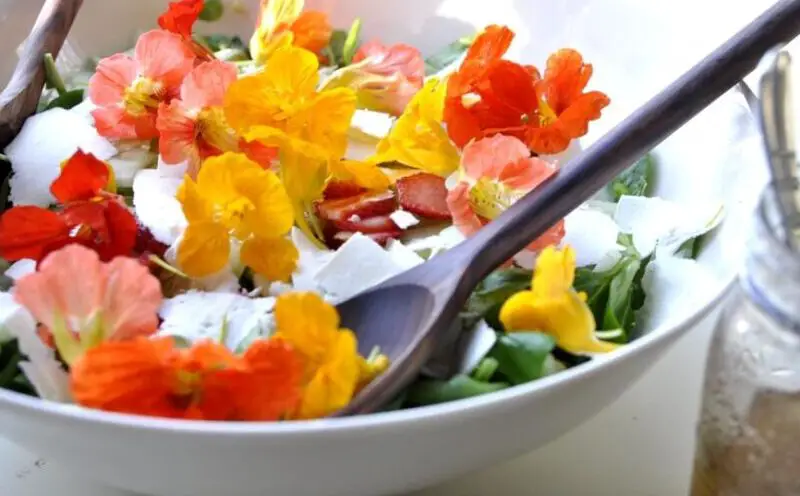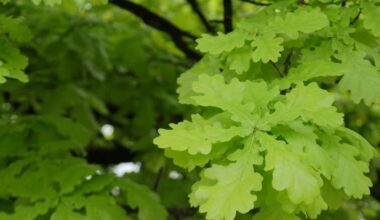Using flowers from the garden to accompany your dishes? Here is a good idea! Flowers are used to make infusions, vinaigrettes but also in jam, omelettes, soups…
Discover the 18 edible flowers to add to your plate without hesitation!
Contents
18 flowers you can eat
1 and 2. Chives and spring onions
Chives and spring onions form a herbaceous tuft, whose hollow stems have a strong garlic scent. The chives show small pink mauve pompons at the end of the stems in late spring and early summer, while the chives are taller and show beautiful white umbels.
In the kitchen
The flowers of these two herbs have a flavor between garlic and onion. Like the stems, the flowers can be used raw in omelettes, sprinkled on fresh cheese, with meats or fish, and in salads.
3. Lavender
This aromatic plant typical of the South and the Mediterranean scents the garrigues. A beautiful upright clump with grey stems and fine leaves, it displays blue spikes all summer long… lavender of course!
In the kitchen
Its very strong flavor makes it necessary to use it sparingly, both in desserts, where it will enhance fruits such as apricots, and to make drinks. Its fragrance will also accompany game, in light touches in the sauce.
4. Indian carnation
Also called tagetes, the marigold is a very flowering herbaceous plant. Forming a rather low clump, it is adorned with orange-red and yellow flowers from June until the first frost. It can be reseeded very easily.
In the kitchen
Their taste is both a little lemony and slightly spicy, reminiscent of passion fruit or curry when cooked. You can put them in bouquets, soups, fruit salads that the petals will color. Their flavor goes well with poultry. Tagetes flowers can be infused in desserts and drinks.
5. Phlox
The phlox paniculé is a herbaceous perennial which can form an imposing clump of more than 1 m in height for as much broad. An easy plant, it flowers between June and autumn, showing panicles of white or various shades of pink flowers.
In the kitchen
Its sweet and honeyed flavor goes well with desserts, but it can also flavor savory dishes, a salad, and fresh goat cheese. Its flowers can be candied.
6. Rose
A thorny shrub, its flowers are generally very fragrant and appear from May to autumn, single or double, in a wide variety of colors.
In the kitchen
Depending on the cultivar, the flavors of rose petals can be very different, but they often go well with sweet flavors, in raspberry or strawberry desserts. They can also be used to flavour jellies or jams, or can be eaten crystallized. Dried, the petals will go more to flavour savoury dishes.
7. Violet
Flowering from spring to early summer, the violet displays a delicate violet or white flowering very fragrant and is robust, colonizing little by little by reseeding the medium sunny locations.
In the kitchen
The violet has a very delicate fragrance, both sweet and a little bitter. Use its petals in desserts, fruit salads, syrups and liqueurs, as well as in cold soups, jellies, flavored butters, cooked dishes.
8. Zucchini
Cucurbitaceae with huge, hairy leaves, its beautiful yellow trumpet-shaped flowers produce fruit that can be eaten raw or cooked.
In the kitchen
These are the male flowers that we will use in cooking (not to do without the future fruits). The fritters of zucchini flowers are famous, but these flowers can also be stuffed, or decorate omelets or salads, or be pan-fried.
9. Primrose
This plant, which is used to undergrowth, forms a rosette with thick, tightly packed leaves, in the middle of which, in spring, often two-colored flowers take pride of place.
In the kitchen
The bright hues of these flowers precede the sweet flavors of honey and lemon. You will accompany vegetables or salads, a roast veal, soups. Crystallized, they make a great effect on pastries. The petals are also used to make infusions.
10. Marigold
The marigold is a simple flower that grows everywhere as soon as it gets sun. It produces many flat yellow or orange pompons from early spring to mid-autumn.
In the kitchen
Possessing great medicinal properties, the marigold also offers us edible and crunchy flowers, with a little peppery/spicy taste. Like saffron, marigold also colors and perfumes dishes. It is used in soups, sauces, butters, but also in breads and cookies. The petals can be dried or raw.
11. Borage
Borage is an annual plant that grows abundantly in gardens. It blooms between late spring and late summer, forming clusters of intense blue that overhang a gray-green and downy foliage.
In the kitchen
Its iodized cucumber flavor goes very well with the flavors of the sea as well as with vegetables. You will bring freshness to your cocktails or will realize delicious fritters. The leaves are also edible.
12. Nasturtium
Nasturtium is an annual herbaceous plant that climbs very easily, both on the ground and on a fence. It has pretty rounded leaves and orange flowers in quantity between late spring and fall.
In the kitchen
The flowers, but also the leaves, flower buds and seeds, can be eaten in salads, where they add a crunch and a slightly spicy taste similar to black radish or watercress. Embellish fruit salads, accompany fish, shellfish and eggs. The buds can be preserved in vinegar.
13. Begonia
This pretty summer begonia is grown in our climates as an annual when in the ground, but is often set up in pots. It shows beautiful, fleshy, glossy leaves, which can be green but also purple or bronze. The intense colored flowers are constantly renewed all summer long, until the first frost. Most begonias are edible.
In the kitchen
The crunchy, colorful petals with their tangy flavor are a great addition to dishes with sea flavors: fish, shellfish, crustaceans, but also fruit salads or foie gras. Some vegetables, especially cucumbers, go very well with these flavors.
14. Agastache
A perennial that will happily reseed itself, to the point of becoming invasive if you don’t cut off the flowering spikes as soon as they fade, it forms a beautiful tuft of anise-green leaves marbled with mauve, topped with beautiful mauve spikes.
In the kitchen
The taste is powerful, mint licorice at the beginning then drawing on the camphor. They are considered as aromatic plants in North America as well as in Asia and the leaves are used to perfume tea. Chopped, the flowers are used to flavour vinaigrettes, white cheeses and cereals. The flavor of the leaves and flowers goes very well with tomatoes.
15. Woodruff
A pretty little perennial plant, the woodruff, or scented bedstraw, can be found in undergrowth, at the foot of trees, which it covers with its pretty little white flowers throughout the spring.
In the kitchen
You will use the flowers in desserts or sweets in which it gives a vanilla taste. You can also make liqueurs with it. Do not overdose because of its coumarin content.
16. Campanula
This pretty plant is a biennial, which forms a rather high clump brightened up by small bell-shaped pale blue to mauve flowers arranged in loose clusters.
In kitchen
The whole plant is edible, the leaves are cooked like spinach and the flowers as well as the roots when they are young, with their taste of fresh lettuce, are used in salads. The roots can also be cooked, like all root vegetables.
17. Cosmos
An annual herbaceous plant, cosmos reproduces itself. It has extremely fine, cut foliage, punctuated all summer until the first frosts by bright pink flowers (depending on the cultivar) with a yellow center.
In the kitchen
Often used as an edible decoration, the flowers have a very sweet floral flavor. Their shape allows to make very surprising mini containers!
18. Hibiscus
A beautiful and popular shrub that can be used as a hedge or in isolation, the garden hibiscus, commonly called althea, is covered from July until the first frost with countless ephemeral flowers that are constantly renewed. This generous bloom can be white, pink or mauve depending on the cultivar.
In the kitchen
The flowers, dried or fresh, color and perfume champagne and kirs, as well as sorbets and ice creams.
Summary
Be careful, if many of the flowers are edible: make sure this is the case for the variety you want to eat. Some parts may be edible and others not. Consult a botanical guide and a pharmacist and if in doubt choose another plant.









